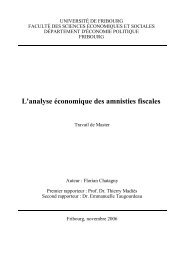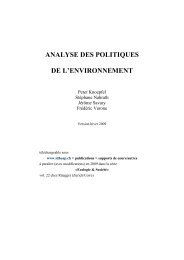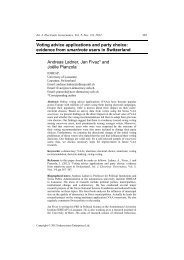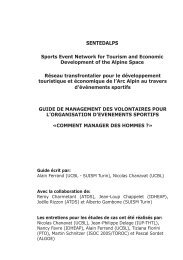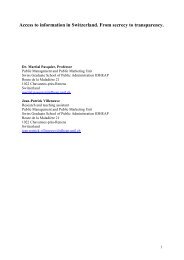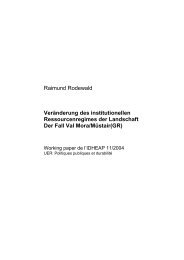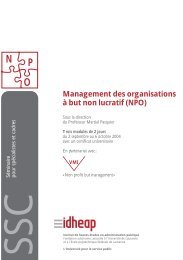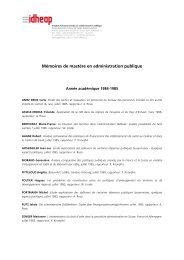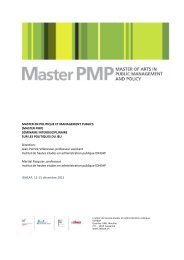Historical Analysis of Institutional Regimes in Switzerland ... - IDHEAP
Historical Analysis of Institutional Regimes in Switzerland ... - IDHEAP
Historical Analysis of Institutional Regimes in Switzerland ... - IDHEAP
You also want an ePaper? Increase the reach of your titles
YUMPU automatically turns print PDFs into web optimized ePapers that Google loves.
21<br />
seal<strong>in</strong>g <strong>of</strong> the soil (particularly due to state transport <strong>in</strong>frastructure) were now perceived as urgent<br />
environmental problems. The triggers for this extended political problem def<strong>in</strong>ition <strong>in</strong>cluded the<br />
adoption <strong>of</strong> the “Rothenthurm Initiative” on the protection <strong>of</strong> moor landscape (1987), <strong>in</strong>itial reports<br />
about contam<strong>in</strong>ated abandoned waste sites and the <strong>in</strong>ternational biodiversity debate <strong>in</strong> the context <strong>of</strong><br />
the concept <strong>of</strong> “susta<strong>in</strong>able development” (Brundtland Report). Soil policy now aimed to fight the<br />
destruction <strong>of</strong> liv<strong>in</strong>g space and loss <strong>of</strong> biodiversity which were the results <strong>of</strong> all k<strong>in</strong>ds <strong>of</strong> land<br />
conversions. The aim <strong>of</strong> the protection <strong>of</strong> soil <strong>in</strong> general is, therefore, the long-term preservation <strong>of</strong><br />
soil fertility and hence also the preventive limitation <strong>of</strong> emissions at source (<strong>in</strong> l<strong>in</strong>e with the Federal<br />
Law on the Protection <strong>of</strong> the Environment <strong>of</strong> 1983). This soil protection policy is based on the<br />
<strong>in</strong>tensification <strong>of</strong> previous regional development, environment and nature conservation policies (uses<br />
with<strong>in</strong> and outside construction zones that promote the protection <strong>of</strong> soil) as well as the <strong>in</strong>troduction<br />
<strong>of</strong> ecological equalis<strong>in</strong>g mechanisms (“compensation pr<strong>in</strong>ciple”), an <strong>in</strong>strument that had been familiar<br />
for some time <strong>in</strong> forest policy. The modes <strong>of</strong> control comb<strong>in</strong>e traditional regulative <strong>in</strong>struments (limit<br />
values, <strong>in</strong>ventories and zon<strong>in</strong>g) with additional <strong>in</strong>centive-based modes <strong>of</strong> control. The general<br />
services provided by agriculture <strong>in</strong> the fulfilment <strong>of</strong> ecological functions <strong>in</strong> rural areas are rewarded<br />
by direct payments. The state and the cantons pay make ecological compensation payment for the<br />
implementation <strong>of</strong> special methods <strong>of</strong> production and farm<strong>in</strong>g (fertiliser balanc<strong>in</strong>g, ecological<br />
compensation areas, valuable arable and recreation landscapes), which are implemented on a<br />
voluntary basis (<strong>in</strong> accordance with Article 18b Paragraph 2 <strong>of</strong> the Federal Law on the Conservation<br />
<strong>of</strong> Nature and Habitats <strong>of</strong> 1987 and Article 31b Paragraph 2 <strong>of</strong> the Federal Law on Agriculture <strong>of</strong><br />
1992).<br />
IR type: We def<strong>in</strong>e the soil IR as complex because the aim is to guarantee a susta<strong>in</strong>able policy which<br />
will regulate and halt the disappearance <strong>of</strong> ecologically valuable natural soil ecosystems as a result <strong>of</strong><br />
their ongo<strong>in</strong>g transformation <strong>in</strong>to transport, settlement, <strong>in</strong>dustrial and commercial areas, which are <strong>of</strong><br />
low value <strong>in</strong> ecological terms. The aim is to elim<strong>in</strong>ate emissions that are harmful to soil <strong>in</strong> these areas<br />
us<strong>in</strong>g environmental plann<strong>in</strong>g measures. The desired <strong>in</strong>terpolicy co-ord<strong>in</strong>ation requires the return <strong>of</strong><br />
ecologisation <strong>in</strong> the areas and the systematic <strong>in</strong>tegration <strong>of</strong> soil protection policy <strong>in</strong>to regional<br />
development. Hence, what is needed is better co-ord<strong>in</strong>ation <strong>of</strong> property and use rights (which are<br />
associated with land ownership) and policy designs (which are not necessarily associated with<br />
specific land owners).<br />
e) Forest (<strong>in</strong>tegrated IR)<br />
Goods and services: The goods and services provided by the resource are manifold and <strong>in</strong>clude<br />
wood, protection aga<strong>in</strong>st avalanches, leisure and recreation activities, ecological amenities etc. Most<br />
forest products are not provided by markets and <strong>in</strong> comparison with other countries, <strong>in</strong> <strong>Switzerland</strong> a<br />
large amount <strong>of</strong> public money has been <strong>in</strong>vested <strong>in</strong> the production and ma<strong>in</strong>tenance <strong>of</strong> non-market<br />
benefits. In mounta<strong>in</strong> areas for example, forests are critical for the protection <strong>of</strong> human settlements<br />
and <strong>in</strong>frastructure aga<strong>in</strong>st avalanches, landslides and rock falls. Furthermore, forests are home to<br />
35% <strong>of</strong> all flora and fauna species. Leisure activities are also <strong>of</strong> great importance. A previously<br />
significant private commodity, wood has partially rel<strong>in</strong>quished its importance over the past two<br />
decades. S<strong>in</strong>ce 1987, public forest enterprises <strong>in</strong> <strong>Switzerland</strong> can no longer cover their expenditure<br />
with subsidies and <strong>in</strong>come from timber sales. One strategy that has been promoted by state actors<br />
and the Swiss forest association is the market<strong>in</strong>g <strong>of</strong> external effects and design <strong>of</strong> new forest<br />
products. (Limacher et al. 1999: 13)



